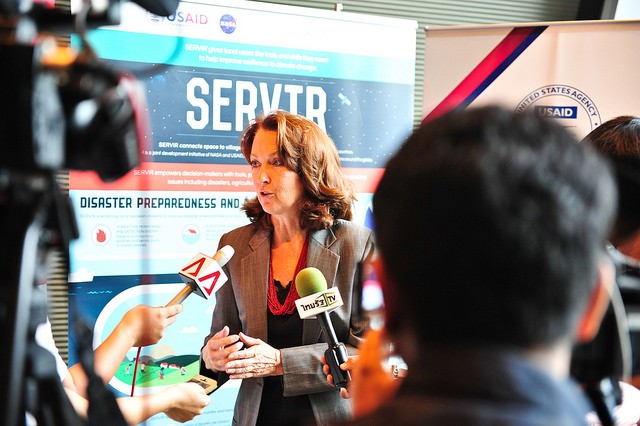
Thank you for joining us at the launch of SERVIR-Mekong, the third hub in the Global SERVIR network.
We at USAID are proud to partner with NASA on SERVIR because we – and the development community more broadly – are just scratching the surface of how geospatial information can be applied to address a wide range of development challenges.
As SERVIR has already been doing in Eastern and Southern Africa and across the Hindu-kush Himalaya region, SERVIR-Mekong will help governments and other key decision-makers in Cambodia, Laos, Myanmar, Thailand and Vietnam take advantage of NASA’s publicly available satellite imagery and geospatial analyses.
These tools help make more informed decisions on critical issues that impact people across the region, such as water management, land use planning, disaster risk reduction, infrastructure development and natural resources management. And informed decisions about issues such as these can save lives, preserve livelihoods and bring about greater resiliency in communities. That’s what drives all of us to embrace this partnership.
We are proud to partner with a strong team of dedicated institutions. SERVIR-Mekong is implemented by the Asian Disaster Preparedness Center and its consortium partners: Spatial Informatics Group, Stockholm Environment Institute and Deltares. Drawing on their talent and innovation, we are tapping into the best available science and technology to help protect this region’s vital ecosystems and the benefits they provide to society. Already, Asian scientists and NASA scientists are working together to develop tools to build resilience and contribute to tackling some of the region's most pressing development challenges.
And there is plenty of work to do. In the Lower Mekong, 75 percent of the population is dependent on agriculture-based livelihoods. It is home to three of the largest rice producing countries in the world. However, recent climate modeling studies have indicated that the Mekong is extremely vulnerable to climate change impacts and extreme climate events.
It is estimated that unpredictable and more extreme weather resulting from climate change could damage $18 billion worth of infrastructure and decrease economic productivity in this region by $16 billion annually by 2050.
These projections underscore the need for reliable, up-to-date information to inform decision-making now to help build the resilience of governments and communities to disasters and more effectively manage water and land resources.
At USAID, we are committed to strengthening local organizations to promote sustainable, long-term development impact. We were pleased to be able to select the Asian Disaster Preparedness Center to host the SERVIR-Mekong hub. With NASA’s technical expertise and access to information, USAID’s development focus and ADPC’s experience in the region, we believe SERVIR-Mekong will be able to improve decision-making and policy-making related to environment management and disaster preparation and response that can benefit all of the people in the Mekong Region.
Science, technology and innovation are high priorities for USAID globally and for our regional office here in Bangkok. We expect to continue to work closely with NASA and local institutions such as ADPC to help us jointly build resilient societies and fight extreme poverty.







Comment
Make a general inquiry or suggest an improvement.